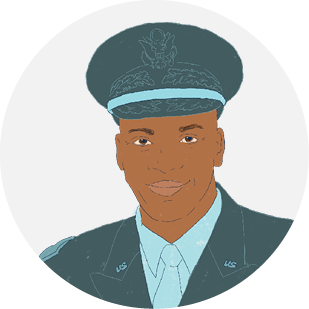I feel like I had enough time, I just didn’t know what to do. That's the difficult part about transitioning out: no one in the military has transitioned out, so there isn't someone that can explain how to do it.
Where we are
Each year, approximately 200,000 Service members leave the military and must reorient their lives. This includes fundamentals like their employment and education, finances, housing, health, and even relationships.
Existing research shows that navigating the military transition can be burdensome and confusing for Veterans, their families, and their supporters. While progress has been made, data suggests that around half of all recently separated Veterans don't connect with available resources and benefits for several years, and sometimes only when they are in crisis. Improving military-to-civilian transition can serve as early intervention to downstream challenges with Veteran homelessness, suicide, health, unemployment and underemployment, and poverty. Addressing these challenges can have lasting ripple effects on a community of approximately 43 million Veterans, family members, survivors, and caregivers.

Our approach
To start, we listened to people’s stories.
The Life Experience research team spoke with Service members, Veterans, and other military-connected people nationwide about this moment in their lives and where the government process could have been simpler and more helpful. The listening sessions captured honest conversations about peoples' experiences, candid feedback on what could have worked better, and what really made a difference for them. Their stories have been combined and are represented here through illustrations. The quotes are real, but names have been changed.












Overall, the team spoke with 200 people through interviews as well as site visits to military installations.
The team spoke with:
- 50 recently separated Veterans
- 71 transitioning Service members
- 10 family members
- 69 individuals from the Department of Defense, Department of Labor, Department of Veterans Affairs, and community subject matter experts
Discovery insights
Framing for collective thinking about customer pain points
How might we provide a transparent transition process that focuses on the future success of the transitioning Service member?
How might we help transitioning Service members approach social reintegration in a genuine and dedicated way before and after separation?
How might we provide equitable, relevant, and high-quality individualized guidance and clear instructions available throughout the transition process?
How might we consider opportunities to improve existing military resources that ease the Service members’ reintegration post-separation?
Design Phase
Designing customer-centered solutions
View progress on our milestonesDesign phase pilot projects aim to build on discovery phase insights on priority customer pain points to tackle. Teams will develop and prototype solutions to measure what works. The design phase work will remain rooted in a human-centered approach, including customers in co-design and testing. The design phase will run through Fiscal Year 2023.
The project aims to prototype a new digital solution that provides customized and integrated information for Service members on service transition elements (e.g., education/skills, employment/career, family/community, finance, health and well-being, and housing), which is individualized based on their potential career pathways, service tenure, and service separation date.
Project objectives
The design phase work to develop the prototype will help surface relevant tools, resources, benefits, and information available across government based on alignment with individual Service member and family goals and their individualized separation timeline. The design phase includes building paper-based products to support Service member transition planning.
Target milestones in 2023 include:
- Facilitate co-design sessions with partner agencies
- Define the Minimum Viable Product (MVP) digital solution and the requirements for scaling
- Build paper versions of curated checklists and customer journeys
- Convene the Joint Executive Committee and agency stakeholders to review the MVP and facilitate decision-making about scaling
Primary deliverables in 2023 include:
- Paper versions of curated checklists and customer journeys for Service members
- Agency operating model (service blueprint) of an MVP digital solution
- Resourcing model to support decision-making about scaling the MVP
Measures of success
Key outcomes:
In 2023, gain cross-agency concurrence to develop and build the MVP digital product. The long-term outcome of this solution aims for an increase in the number of Service members who feel prepared for their transition.
Design phase project measures:
- Integrate the paper-based products into the transition preparation process at select Service installations
- Increase the number of Service members who are prepared for and confident in transition
- Increase in the number of preventative resources/referrals provided through a customized filter
- Increase in the number of preventative resources/referrals accessed
- Increase trust in VA (measured through VA Trust Survey) among Veterans under 40
Project Documentation
- Project Charter
- Project One-Sheet
- Design Project Summary
- Customer Journey Map & Stories
- Information collection approved under OMB Control #2900-0876
- Life Experience Initiative Summary
- Executive Order 14058
- President’s Management Agenda
Agency collaborators
- General Services Administration (GSA)
- Department of Labor (DOL)
- Department of Housing and Urban Development (HUD)
- Office of Management and Budget (OMB)
- Department of Education (ED)
- Department of Defense (DOD)
- Department of Veterans Affairs (VA)
- Office of Personnel Management (OPM)
- Small Business Administration (SBA)
